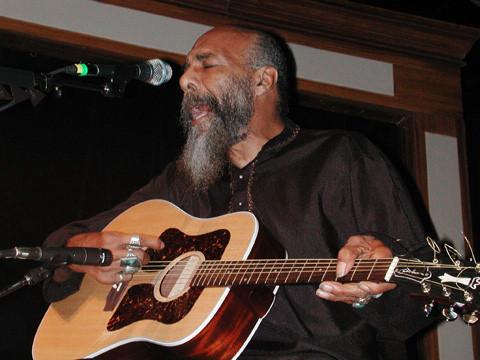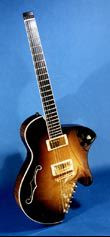Much like Richie Havens, Brozman interests lie in Folk Music. However in his case the type of folk music he performed and studied included Gypsy, Jazz, Calypso, Blues, Ragtime, Hawaiian and Caribbean music.
Brozman collaborated with musicians from Africa, India, Japan, New Guinea, Trinidad, and other islands.
In addition to performing,
his studies in ethnomusicology led him to an adjunct professorship at the Department
of Contemporary Music Studies at
Brozman was a fount of
knowledge when it came to American music of the 20th Century.
He recorded numerous albums, books and video tutorials.
He was a three time winner of the Guitar Player Magazine Readers Poll. Brozman kept up a steady world wide tour
schedule and founded guitar seminars.
His tours were remarkable. He was very recognizable from his dark hair and dark beard. Bob Brozman generally performed solo with several of his silver plated National guitars , his National ukulele, and a Bear Creek lap steel.
His tours were remarkable. He was very recognizable from his dark hair and dark beard. Bob Brozman generally performed solo with several of his silver plated National guitars , his National ukulele, and a Bear Creek lap steel.
Brozman is best known for his use of National resonator instruments from the 1920’s and 1930’s. He also used a Weissenborn hollow neck acoustic as a lap steel and a baritone version of a National Tri-cone resonator guitar and a National resonator concert ukulele.
He was not only the worlds preeminent authority on National steel string resonator instruments, Bob was an amazing instrumentalist.
Brozman developed a love
for world music as a boy, listening to Calypso songs from Trinidad and the traditional
music of Hawaii
His field of undergraduate study was ethnomusicology at Washington University of St. Louis. During his college years he would trek through the southernUnited States
His field of undergraduate study was ethnomusicology at Washington University of St. Louis. During his college years he would trek through the southern
During these days he
learned how to play slide guitar, using a home-made slide that was actually the neck of a wine bottle.
As a music anthropologist Bob was very interested in what happens musically with the guitar when it is left behind in a country and culture that knew nothing about the guitar.
Brozman was a contributor to several guitar publications and did instructional videos for Happy Truam’s Homespun Tapes. Bob Brozman was also associated with and endorsed Bear Creek Guitars. Bear Creek makes accurate and extremely well made reproductions of Weissenborn style hollow body lap steel guitars as well as steel string guitars and ukuleles.
Bob Brozman may have been better known throughout other parts of the world than in the






































